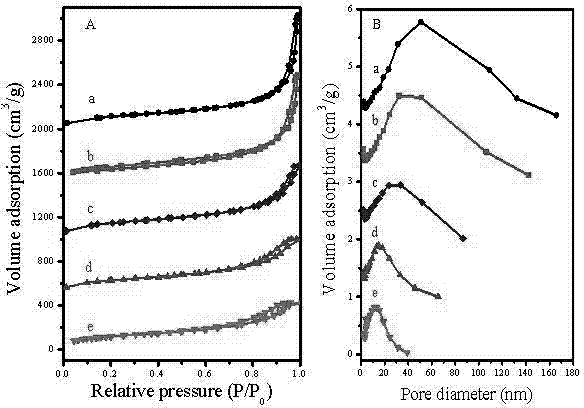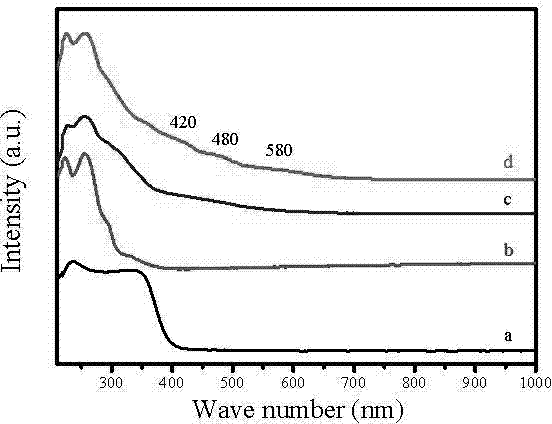Preparation method of titanium dioxide-mesoporous polymer nanoporous composite visible light catalytic material
A nanoporous and titanium dioxide technology, applied in the field of material science, can solve the problems of poor thermal stability and unfavorable product separation, and achieve good adsorption performance, excellent visible light catalytic degradation ability, and excellent visible light catalytic degradation performance.
- Summary
- Abstract
- Description
- Claims
- Application Information
AI Technical Summary
Problems solved by technology
Method used
Image
Examples
Embodiment 1
[0034] Firstly, titanium dioxide-mesoporous polymer nanoporous composite visible light catalytic material, namely PDVB-VI-TiO, was synthesized by using ethyl acetate solvent and imidazole as functional monomers. 2 - xs (where xs represents the molar ratio of titanium species to imidazole in the material).
[0035] Add 2.0g DVB, 0.72g 1-vinylimidazole (VI) to the mixed solution containing 0.065g AIBN and 25mL ethyl acetate, then add 2.5mL n-butyl titanate (TBOT), stir at room temperature for 3 hours, 100℃ After hydrothermal treatment for 24h, a brownish-yellow blocky solid was obtained. In order to fully crystallize the titanium dioxide in the material, open the lid of the reactor after hydrothermal treatment, add 2-3mL of water, continue the hydrothermal treatment at 160°C for 24 hours, take it out, open the lid, and volatilize the solvent to obtain PDVB-VI-TiO 2 -0.92. During the synthesis process, DVB / AIBN / VI / TBOT / ethyl acetate (molar ratio) was 1 / 0.026 / 0.5 / 0.46 / 16.7.
Embodiment 2
[0037] Titanium dioxide-mesoporous polymer nanoporous composite visible light catalytic materials were synthesized with ethyl acetate solvent and imidazole as functional monomers, and the content of titanium species in the materials was adjusted.
[0038] Add 2.0g DVB, 0.72g 1-vinylimidazole (VI) to the mixed solution containing 0.065g AIBN and 25mL ethyl acetate, then add 1.25mL n-butyl titanate (TBOT), stir at room temperature for 3 hours, 100℃ After hydrothermal treatment for 24 hours, a brownish-yellow blocky solid was obtained. In order to fully crystallize the titanium dioxide in the material, open the lid of the reactor after hydrothermal treatment, add 2-3mL of water, continue the hydrothermal treatment at 150°C for 24 hours, take it out, and open the lid. The solvent is volatilized to obtain PDVB-VI-TiO 2-0.46. During the synthesis process, DVB / AIBN / VI / TBOT / ethyl acetate (molar ratio) was 1 / 0.026 / 0.5 / 0.23 / 16.7.
Embodiment 3
[0040] In the process of synthesizing titanium dioxide-mesoporous polymer nanoporous composite visible light catalytic materials, the synthesis solvent in the synthesis process of materials is modulated.
[0041] Add 2.0g DVB, 0.72g 1-vinylimidazole (VI) to the mixed solution containing 0.065g AIBN and 20-30mL tetrahydrofuran, then add 2.5mL n-butyl titanate (TBOT), stir at room temperature for 3 hours, 100℃ After hydrothermal treatment for 24 hours, a brownish-yellow blocky solid was obtained. In order to fully crystallize the titanium dioxide in the material, open the lid of the reactor after hydrothermal treatment, add 2-3mL of water, continue the hydrothermal treatment at 150°C for 24 hours, take it out, and open the lid. The solvent is volatilized to obtain PDVB-VI-TiO 2 -0.92. DVB / AIBN / VI / TBOT / THF was 1 / 0.026 / 0.5 / 0.46 / 16.7 during the synthesis process.
PUM
| Property | Measurement | Unit |
|---|---|---|
| specific surface area | aaaaa | aaaaa |
| pore size | aaaaa | aaaaa |
| adsorption capacity | aaaaa | aaaaa |
Abstract
Description
Claims
Application Information
 Login to View More
Login to View More - R&D
- Intellectual Property
- Life Sciences
- Materials
- Tech Scout
- Unparalleled Data Quality
- Higher Quality Content
- 60% Fewer Hallucinations
Browse by: Latest US Patents, China's latest patents, Technical Efficacy Thesaurus, Application Domain, Technology Topic, Popular Technical Reports.
© 2025 PatSnap. All rights reserved.Legal|Privacy policy|Modern Slavery Act Transparency Statement|Sitemap|About US| Contact US: help@patsnap.com



